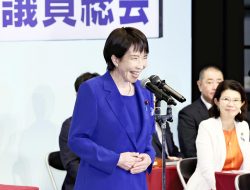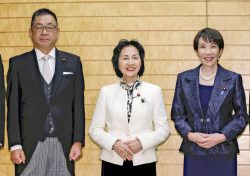
Prime Minister Fumio Kishida walks in the Prime Minister’s Office on Sept. 13, ahead of an attestation ceremony at the Imperial Palace.
8:00 JST, September 23, 2023
Prime Minister Fumio Kishida reshuffled his Cabinet and the leadership of the ruling Liberal Democratic Party on Sept. 13. Pundits have been trying to interpret his political strategy in the reshuffle. A key question, I think, is this: Is he a risk-taker or a hedger?
Before diving into deep analysis, let’s start by looking at his political foundation in the balance of power among LDP factions. The prime minister leads the Kishida faction. With 46 members, it is the fourth largest faction in the party. The biggest one is the Abe faction with 99 members, followed by the Aso faction with 55 members and the Motegi faction with 54.
These numbers clearly show that Kishida’s political foundation isn’t solid. To run his administration in a stable manner, he needs to gain other major factions’ support. And in fact, he has been allied with LDP Vice President Taro Aso and LDP Secretary General Toshimitsu Motegi, who each head their eponymous factions, and he has maintained a good relationship with the Abe faction with appointments for five key members: LDP Policy Research Council chairperson Koichi Hagiuda; LDP House of Councillors Secretary General Hiroshige Seko; Economy, Trade and Industry Minister Yasutoshi Nishimura; Chief Cabinet Secretary Hirokazu Matsuno; and LDP Diet Affairs Committee chairperson Tsuyoshi Takagi.
As he planned the reshuffle, Kishida was looking down the road toward the LDP presidential election to be held in autumn next year. He stood at a strategic fork in that road.
One of the two paths he could have taken was to continue his political alliance with Aso and Motegi while also keeping up good relations with the Abe faction. This path would keep his administration stable for the time being, but at the same time it would bring the risk of Kishida losing support within the party and being dragged down if his approval ratings were to remain sluggish. Taking this option would mean keeping Aso, Motegi and the five key members of the Abe faction in office, as well as considering other factions’ requests regarding Cabinet appointments. He could then try to win another term as LDP president without first holding a general election.
The other path he could have taken was to risk holding a general election by dissolving the House of Representatives after the Cabinet reshuffle. If Kishida could lead the LDP to victory in the election, he would win another term as LDP president virtually unopposed. But if the LDP were to lose, Kishida would become a lame duck whose reelection would be impossible. If he were to choose this riskier path, he would have to reshuffle his Cabinet dramatically and promote some ambitious members — such as Yuko Obuchi, the daughter of former Prime Minister Keizo Obuchi, and Shinjiro Koizumi, the son of former Prime Minister Junichiro Koizumi — to important posts. In the most extreme scenario, Kishida might consider replacing Motegi as party secretary general with Obuchi. She belongs to the Motegi faction but is also a potential rival for him. Had Kishida chosen this path, Obuchi would have become the first woman to serve as LDP secretary general, a situation Kishida’s aides believed would electrify the public. In short, this option would likely be followed by a snap election.
Now, with those two paths in mind, let’s see how Kishida actually dealt with the Cabinet reshuffle. First, he kept Aso, Motegi and the five key members of the Abe faction in office in order to stabilize his foundation. Second, he picked Yuko Obuchi as chairperson of the Election Strategy Committee in the LDP. Third, he appointed a record-tying five women to show his willingness for political reform. Fourth, 11 of 19 ministers were first-time Cabinet appointments, but most of them were chosen based on factions’ recommendations.
The point is that Kishida is trying to get the best of both worlds. Maybe he wants to keep two different options open. One option is to seek reelection in next year’s LDP presidential election without taking the risk of a general election first. The other option is to call a snap election and win it, thus paving the way to a virtually uncontested win in the LDP presidential election. Presumably, he will choose which option to take at the last minute.
But stability and risk-taking are mutually exclusive. This reshuffle gave people a mixed message. In a poll conducted immediately after the reshuffle by The Yomiuri Shimbun, only 27% of respondents saw the reshuffle positively and 50% saw it negatively — even though 72% valued the fact that the new Cabinet includes five women. Opinion on Obuchi’s appointment was divided, with 37% approving it while 44% did not. Her political funding scandal, which came to light in 2014, still casts a shadow, as she couldn’t explain certain unspecified expenditures clearly enough to win public understanding.
The approval rating for the Cabinet remained unchanged at 35% overall. This result has raised the bar for Kishida when he considers holding a snap election. But it is still possible for him to dissolve the lower house and win in the general election because opposition parties have remained uncompetitive. In recent polls, not a single opposition party has had more than single-digit support while the LDP has enjoyed support ratings of 30% or above. Kishida likely hasn’t decided whether he will hold a general election before next autumn’s LDP presidential election. He may keep hedging his bets between a stable option and a risk-taking one.
Kishida may find himself lost after not choosing one clear way at the fork in the road. Closer to next fall without a general election, there may be a greater risk of Kishida losing support within the party. As a famous proverb says, “If you run after two hares you will catch neither.” Kishida may cut himself off from both paths to reelection unless luck is with him.
Political Pulse appears every Saturday.

Satoshi Ogawa
Satoshi Ogawa is the editor of the Political News Department of The Yomiuri Shimbun.
"Editorial & Columns" POPULAR ARTICLE
-

Violations of Subcontract Law: Major Automakers Must Eliminate Old Practices
-

Local Governments’ Tax Revenues: Devise Ways to Correct Imbalances in Tax Sources
-

5 Japanese Business Dinner Mistakes to Avoid — and What They Taught Me About Business in Japan
-

Heavy Rains in Asia: Support for Victims, Flood-Control Measures Urgently Needed
-

Rice Coupons: A Misguided Approach to Countering Rising Prices
JN ACCESS RANKING
-

Keidanren Chairman Yoshinobu Tsutsui Visits Kashiwazaki-Kariwa Nuclear Power Plant; Inspects New Emergency Safety System
-

Imports of Rare Earths from China Facing Delays, May Be Caused by Deterioration of Japan-China Relations
-

University of Tokyo Professor Discusses Japanese Economic Security in Interview Ahead of Forum
-

Japan Pulls out of Vietnam Nuclear Project, Complicating Hanoi’s Power Plans
-

Govt Aims to Expand NISA Program Lineup, Abolish Age Restriction
























